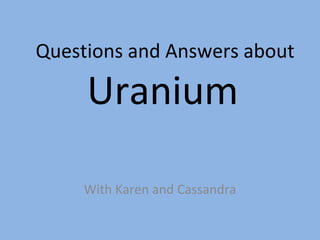
Uranium
- 1. Questions and Answers about Uranium With Karen and Cassandra
- 2. What is Uranium? What is Uranium, Cassie? Well Karen, Uranium is a very important and radioactive element. Uranium’s atomic number is 92 and it’s part of the Rare Earth Element Group. What is Uranium used for? Uranium has many uses and purposes. For a long time Uranium was used as a pigment for glass. Like that. But nowadays, it is most commonly used in nuclear reactors and in nuclear bombs.
- 4. Uranium Well since uranium is radioactive, that means it causes illnesses like cancer, right? Hmmm. Uranium has good and bad effects on human health. Too much exposure to uranium can cause chemical and radiological toxicity. A common effect of too much uranium exposure includes kidney problems right? Right. High uranium intake can cause your kidneys to stop working and can cause death. Unfortunately, you do not experience symptoms until it is too late. And uranium exposure causes cancer too? Exposure to depleted uranium increases your risk of some radiation-induced cancers, like leukemia. Lung cancer can also be caused by breathing in uranium particles. Can this happen to anyone? EVERYONE in the world is exposed to uranium, even if they don’t work or live near a nuclear power plant or uranium mine. We are exposed to uranium by the water we drink and the air we breathe, even at this very moment. It’s just not in large enough portions to cause something bad to happen.
- 5. That’s a picture of “Little Boy”, the uranium bomb dropped on Hiroshima in 1945. Uranium in World War II Hiroshima was totally destroyed after the bomb, in fact, over 66,000 people were killed because of the bomb. Many people received radiation burns because of the bomb. There were some people that had clothing patterns burned onto the skin because of the heat rays! There were a couple people that had received radiation burns even though they were about 2 km away from the hypocenter. So many people and so many things were lost that day. About 2/3 of Hiroshima’s beautiful buildings and architecture were destroyed. “Little-Boy” was made using U-235, a radioactive isotope of uranium.
- 6. Uranium Mining! In the last 60 years, uranium has become one of the world’s most important energy minerals. It is used mostly for making electricity. Since Uranium is a naturally-occurring element, it is found in the Earth’s crust. Traces if it are almost EVERYWHERE! There are different types of mines. There are open pit mines and underground mines. Where “orebodies” lie close to the surface, they are usually accessed by open pit mines. Where “orebodies” are deeper into the Earth’s surface, they use underground mining. Open pit mine Underground mine An example of an open pit mine would be the Ranger mine in Australia and an underground mine would be the Olympic dam mine in Australia.
- 7. Uranium Mines! As you can see, most of the mines in the United States are located in the West. There are many mines in the United States but the country with the most mines in the world is believe it or not, is Kazakhstan! Kazakhstan produces the largest share of uranium from their mines. They produce 27% of the world’s supply! Followed by Canada and Australia . Kazakhstan has 15% of the world’s uranium resources and it aims to supply 30% of the world fuel production market in the near future.
- 8. Did You Know? Fun facts of Uranium Did you know that a one-foot cube of uranium weighs more than 1,000 pounds?! Did you know that one pound of Uranium will make a ball only 1.3 inches in diameter? Did you know that there are 104 U.S nuclear power plants that produce over 20% of our electricity? Did you know that uranium that is split finely burns in the air at 300-350 ° F? Did you know that in the whole world there are about 440 nuclear power plants? Did you know that uranium is the heaviest naturally occurring element on Earth?
- 9. Thank You for Reading about Uranium!
